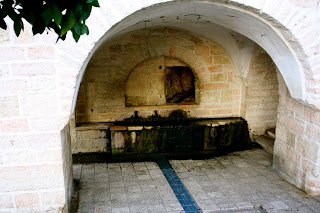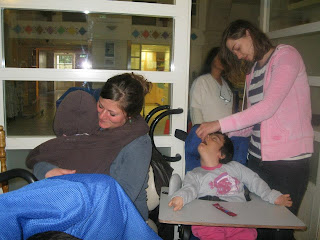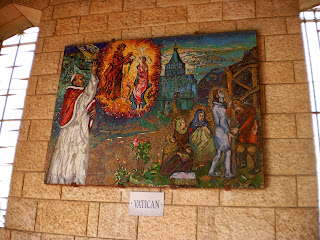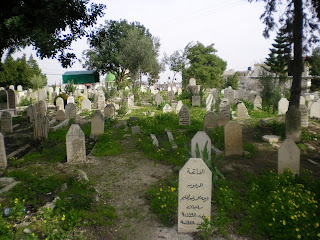Thoughts on the Holy City:
-There is a wide spectrum of religion and spirituality in Jerusalem. I mostly worked with Israelis, spending little time with Arabs and my exposure was to Jews. Most of the people I worked with were secular, not religious at all, although in other labs there were a fair amount of Orthodox Jews as well. But I would say that the academic field is largely dominated by secular Jews. Next you get Orthodox, the Jews that wear the kippa, eat kosher, go to synagogue, and observe Shabbat, holidays, and other Jewish law. I had friends like Moshe and Shimon and the Kovalskis who were Orthodox. Women always wore modest clothes and skirts, and married Orthodox women wore head scarves.
Finally, there were the ultra-Orthodox Jews, the Haredi who dressed up in black suits and hats and had ringlets and beards. These Jews often spoke Yiddish and didn't associate with others, living off the welfare system in order to study Torah all day and incurring the wrath of most other Israelis. They had a lot of children and were poor. I don't think I ever talked to the Haredi except once when I was lost in Mea Shearim late at night and asked directions to the Central Bus Station.
Some of the Orthodox women were dressed so beautifully, especially with the head scarves. In a lot of ways they looked similar to LDS women, especially the American Orthodox Jews, with their knee-length skirts and modest tops. But they had figured out how to do it right and they made a whole style out of it.
The few things I remember about my interaction with Muslims is that they all fasted for the whole month of Ramadan and that Friday afternoons are really busy in the Old City as everyone goes to the mosque. The prayer calls 5 times a day! I remember my Muslim friend Abed telling me how Jerusalem was a holy, spiritual city and there was just something special about living here (he was from northern Israel).
-Culturally, being in Israel was sometimes tough because people were often abrupt and very straightforward with how they felt. Customer service was non existent! Driving was I remember going to my bank to deposit a check and it took almost an hour! No one knew what line I should go in, who I was supposed to talk to, and when I finally did find someone that would help me, she stood there with the check typing in her computer for probably 15 minutes! Ha! I thought depositing a check is one of the simplest functions a bank could do! But that is completely characteristic of trying to get anything "simple" done in Israel.
-I felt very safe in West Jerusalem, where I lived and worked. I could walk home late at night (and often did, especially with the excruciating experience of missing the last bus to home from the Central Bus Station at midnight). The Arab neighborhoods in East Jerusalem around the Mt Scopus campus and BYU Jerusalem Center were another story, not even I would take the risk of walking in those areas at night. At one point when I was there, Israel had a mini-war with Hamas and the Gaza Strip fired hundreds of rockets into Israel and towards Jerusalem. Only a few got close enough to set off alarms, when I then ran to the bomb shelter across the way from my room, but they didn't reach Jerusalem and no one was hurt.
-Food! Expensive and hard to come by. Falafel and shwarma and pizza were virtually the only fast food available, and the markets were much smaller than American groceries, typically two or three stunted aisles. Hummus was found in abundance. I always had trouble deciphering between yogurt and sour cream. I loved eating fruits and vegetables only in season; I would gorge for a few weeks on what was available and as soon as I couldn't stand any more, it would disappear from the markets, replaced by some new fruit or vegetable. Homemade cheeseburgers were our favorite non-kosher thrill.
-There was tension between Arabs and Jews but I found more tolerance among the more educated. Shikma in the lab talked to me about how Abed was Arab but treated no differently from any other. But my photo shop Israeli friend told me how he hated all Arabs because they are trying to kill him, and trying to talk reason to his all-encompassing ethnic prejudice made no difference. There was very little intermingling and friendship between the two cultures. I found that often the Arabs were much friendlier and more open than the Israelis.
-I can't not say something about all the holy sites in Jerusalem! I visited them many times, holy sites of all three religions. Particularly the Church of the Holy Sepulchre, with its masses of people moving through, kissing the shrines and shedding tears, the Western Wall with the tiny prayer notes stuffed into crevices and prayerful, rocking Jews, the Dome of the Rock with its tight security and intricately decorated tiles. My favorite was always the Garden Tomb, tucked around the corner and the refuge from the bustle of the city. With a group, we would sing hymns, with a friend, we would sit in the shade on one of the many benches and listen to other groups sing, read scriptures, speak in tongues, or otherwise worship. Some of the weeks we would attend Shabbat servies at the Shirah Hadashah feminist synagogue, where they sang some of the most beautiful and inspiring songs I have ever heard.
-Other random things about Jerusalem: all buildings made of limestone, the terrain was so hilly, there always seemed to be some kind of haze over the city, taxi cabs were a necessity especially on Friday nights.
-Of course Jerusalem is rich with history and diversity and religion, but one of the most amazing things to me probably was that it became my own. Between the various houses across the city where I dogsat, the people I knew, places I worked, or sites visited, I walked or bussed most neighborhoods and streets of Jerusalem. I knew that city. It was not only rich with world history, but rich with my history as well. Months would pass and my friends and life would have completely changed, but the streets I walked remained the same and held the memories and people that my current companions would know nothing of.
The first few weeks I would be hit with moments of giddiness, I was living in the Holy City! Late at night, waiting at bus stops, I would be overwhelmed with how lucky I was. But it soon settled into routine, when walking through the Old City was mostly to find a cheap falafel and climbing the Old City walls at night was our "It's a weekend, what should we do for fun?" activity. I arrived having no clue of the layout of the city. I remember being dropped off by the sherut at 3am my first night and not having any idea where I was. Then a month later, passing by the same street and knowing exactly where I was in the city, it was a total transformation. It became my home, my town.
The few things I remember about my interaction with Muslims is that they all fasted for the whole month of Ramadan and that Friday afternoons are really busy in the Old City as everyone goes to the mosque. The prayer calls 5 times a day! I remember my Muslim friend Abed telling me how Jerusalem was a holy, spiritual city and there was just something special about living here (he was from northern Israel).
-Culturally, being in Israel was sometimes tough because people were often abrupt and very straightforward with how they felt. Customer service was non existent! Driving was I remember going to my bank to deposit a check and it took almost an hour! No one knew what line I should go in, who I was supposed to talk to, and when I finally did find someone that would help me, she stood there with the check typing in her computer for probably 15 minutes! Ha! I thought depositing a check is one of the simplest functions a bank could do! But that is completely characteristic of trying to get anything "simple" done in Israel.
-I felt very safe in West Jerusalem, where I lived and worked. I could walk home late at night (and often did, especially with the excruciating experience of missing the last bus to home from the Central Bus Station at midnight). The Arab neighborhoods in East Jerusalem around the Mt Scopus campus and BYU Jerusalem Center were another story, not even I would take the risk of walking in those areas at night. At one point when I was there, Israel had a mini-war with Hamas and the Gaza Strip fired hundreds of rockets into Israel and towards Jerusalem. Only a few got close enough to set off alarms, when I then ran to the bomb shelter across the way from my room, but they didn't reach Jerusalem and no one was hurt.
-Food! Expensive and hard to come by. Falafel and shwarma and pizza were virtually the only fast food available, and the markets were much smaller than American groceries, typically two or three stunted aisles. Hummus was found in abundance. I always had trouble deciphering between yogurt and sour cream. I loved eating fruits and vegetables only in season; I would gorge for a few weeks on what was available and as soon as I couldn't stand any more, it would disappear from the markets, replaced by some new fruit or vegetable. Homemade cheeseburgers were our favorite non-kosher thrill.
-There was tension between Arabs and Jews but I found more tolerance among the more educated. Shikma in the lab talked to me about how Abed was Arab but treated no differently from any other. But my photo shop Israeli friend told me how he hated all Arabs because they are trying to kill him, and trying to talk reason to his all-encompassing ethnic prejudice made no difference. There was very little intermingling and friendship between the two cultures. I found that often the Arabs were much friendlier and more open than the Israelis.
-I can't not say something about all the holy sites in Jerusalem! I visited them many times, holy sites of all three religions. Particularly the Church of the Holy Sepulchre, with its masses of people moving through, kissing the shrines and shedding tears, the Western Wall with the tiny prayer notes stuffed into crevices and prayerful, rocking Jews, the Dome of the Rock with its tight security and intricately decorated tiles. My favorite was always the Garden Tomb, tucked around the corner and the refuge from the bustle of the city. With a group, we would sing hymns, with a friend, we would sit in the shade on one of the many benches and listen to other groups sing, read scriptures, speak in tongues, or otherwise worship. Some of the weeks we would attend Shabbat servies at the Shirah Hadashah feminist synagogue, where they sang some of the most beautiful and inspiring songs I have ever heard.
-Other random things about Jerusalem: all buildings made of limestone, the terrain was so hilly, there always seemed to be some kind of haze over the city, taxi cabs were a necessity especially on Friday nights.
-Of course Jerusalem is rich with history and diversity and religion, but one of the most amazing things to me probably was that it became my own. Between the various houses across the city where I dogsat, the people I knew, places I worked, or sites visited, I walked or bussed most neighborhoods and streets of Jerusalem. I knew that city. It was not only rich with world history, but rich with my history as well. Months would pass and my friends and life would have completely changed, but the streets I walked remained the same and held the memories and people that my current companions would know nothing of.
The first few weeks I would be hit with moments of giddiness, I was living in the Holy City! Late at night, waiting at bus stops, I would be overwhelmed with how lucky I was. But it soon settled into routine, when walking through the Old City was mostly to find a cheap falafel and climbing the Old City walls at night was our "It's a weekend, what should we do for fun?" activity. I arrived having no clue of the layout of the city. I remember being dropped off by the sherut at 3am my first night and not having any idea where I was. Then a month later, passing by the same street and knowing exactly where I was in the city, it was a total transformation. It became my home, my town.






















































































